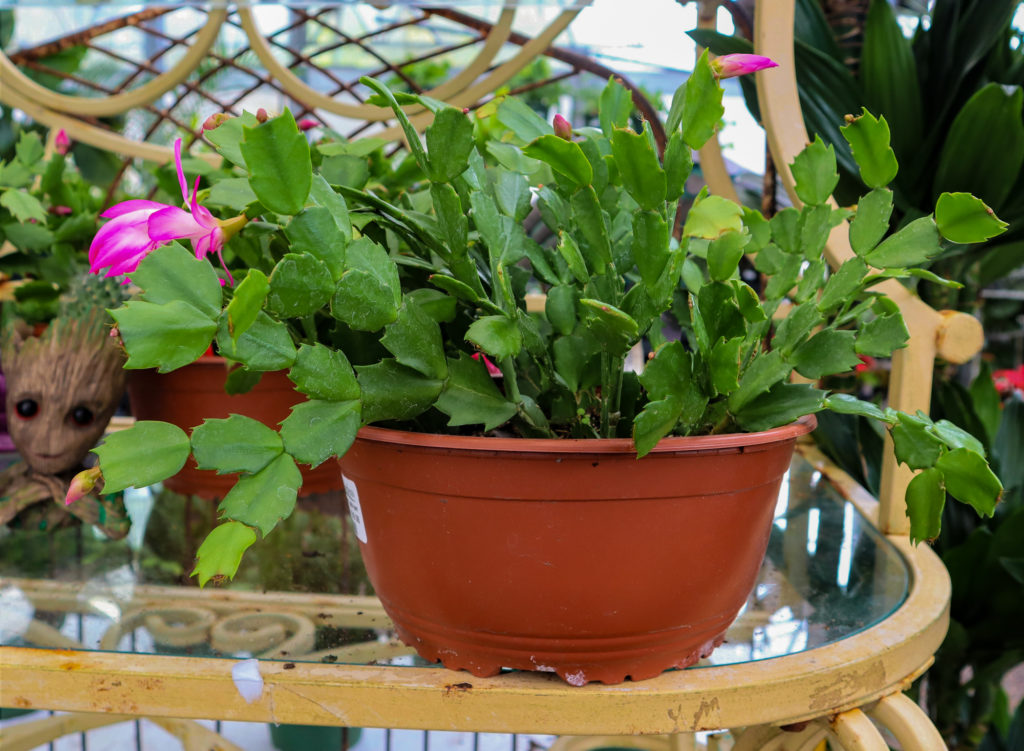by Amanda Rose Newton
Outside of the poinsettia, the Christmas Cactus (Schlumbergera x buckleyi) is the most-purchased houseplant during the Holiday season.

Christmas Cactus is one of those items that gets gifted last minute with the thought it will provide nice color during a rather drab part of the year.
The Christmas cactus truly is the gift that keeps on giving, as it can live happily without much care on your part all year long. Like all cacti and succulents, propagation is as easy as breaking off a piece of the plant, allowing you to make enough to gift to just about everyone, Christmas time or not.

These spiny guys are actually not desert dwellers like their cacti brethren, and hail from the tropics. In fact, they act quite similar to our bromeliads and air plants and prefer to hang out on tree limbs to grab moisture and humidity. This means they might need a bit more water than the cacti we are most familiar with. While proper care is simple, there are a few twists that are worth knowing to promote year-round growth.
Where to Place Christmas Cacti in the Home
Plants should be kept in bright, but indirect light. This is best achieved by seeking out a room with an east-facing window. Never discount a bright bathroom, as this is heaven for humidity-loving plants! You will know if there is too much light if you start noticing white blotches on the leaves. Even plants can get sunburned!
As far as temperature goes, as long as you do not have your air conditioning set to arctic tundra levels, your cactus will thrive. Their sweet spot is in the 60-70°F (15-18°C) range.
In Florida, Christmas cacti can be placed in a semi-shaded spot in the garden or in a covered porch as long as temperatures do not dip below 50 degrees.
Christmas Cacti Care
Like most plants, watering is the most challenging part. As a general rule, watering every 2-3 weeks is a safe bet. When the top 2 inches of the soil are dry, that is generally an indicator that it’s time to water. When watering, water until it is dripping out of the drainage holes, discarding any collected water at the base after a few minutes.

Fertilizer may be needed if you desire blooms. For this species, feeding once a month with a slow-release blooming fertilizer during bloom time (fall-winter) can help encourage blooms. Blooming is usually the area most cacti lovers struggle with and to let you in on the secret, it’s as simple as cutting your cactus back.
Prune plants in the Spring when they are not flowering to encourage even branching and more flowers. To do so, simply cut off a few sections of each stem. When you do so, new growth will come from those injured areas.
Be sure those pieces do not go to waste! To grow more cacti from these pruned pieces, place them on moist soil and wait for small hair-like roots to appear on the ends.

Pests and Diseases of Christmas Cacti
While Christmas cacti are not prone to many issues, unfortunately, the blooms are where they begin. If your Christmas cactus becomes too stressed from moving it too much, getting too much light, or too much reality TV, the plant will drop its blossoms. If this happens, don’t freak out! This can be fixed by making sure you are abiding by the care outlined above.
On rare occasions, especially if living outside, it might be exposed to mealy bugs or scales, which can easily be wiped off with a wet rag or hit with an insecticidal soap blend once a week for 3 weeks.
Over-watering is the leading cause of death for any houseplant, which easily leads to root rot when you are a cactus without a dense root system. Luckily, since it’s a cactus, you can simply cut out the damaged parts and re-pot in clean soil.
What About Easter Cacti?
There are multiple species of blooming cacti that honestly look pretty much the same. The difference is their bloom time and it happens to correspond with other holidays. Enter the Easter and the Thanksgiving cactus. The Easter cactus (S. gartneri) blooms from late winter through April, and the Thanksgiving cactus (S. truncata) blooms from late fall through midwinter.
None of these species are “done” after that! All three will offer you classic foliage year-round with attractive blooms during their respective season.
No matter the holiday, the Christmas cactus is truly a plant of all seasons.


